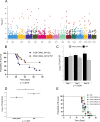Genomic Variation across a Clinical Cryptococcus Population Linked to Disease Outcome
- PMID: 36354332
- PMCID: PMC9765290
- DOI: 10.1128/mbio.02626-22
Genomic Variation across a Clinical Cryptococcus Population Linked to Disease Outcome
Abstract
Cryptococcus neoformans is the causative agent of cryptococcosis, a disease with poor patient outcomes that accounts for approximately 180,000 deaths each year. Patient outcomes may be impacted by the underlying genetics of the infecting isolate; however, our current understanding of how genetic diversity contributes to clinical outcomes is limited. Here, we leverage clinical, in vitro growth and genomic data for 284 C. neoformans isolates to identify clinically relevant pathogen variants within a population of clinical isolates from patients with human immunodeficiency virus (HIV)-associated cryptococcosis in Malawi. Through a genome-wide association study (GWAS) approach, we identify variants associated with the fungal burden and the growth rate. We also find both small and large-scale variation, including aneuploidy, associated with alternate growth phenotypes, which may impact the course of infection. Genes impacted by these variants are involved in transcriptional regulation, signal transduction, glycosylation, sugar transport, and glycolysis. We show that growth within the central nervous system (CNS) is reliant upon glycolysis in an animal model and likely impacts patient mortality, as the CNS yeast burden likely modulates patient outcome. Additionally, we find that genes with roles in sugar transport are enriched in regions under selection in specific lineages of this clinical population. Further, we demonstrate that genomic variants in two genes identified by GWAS impact virulence in animal models. Our approach identifies links between the genetic variation in C. neoformans and clinically relevant phenotypes and animal model pathogenesis, thereby shedding light on specific survival mechanisms within the CNS and identifying the pathways involved in yeast persistence. IMPORTANCE Infection outcomes for cryptococcosis, most commonly caused by C. neoformans, are influenced by host immune responses as well as by host and pathogen genetics. Infecting yeast isolates are genetically diverse; however, we lack a deep understanding of how this diversity impacts patient outcomes. To better understand both clinical isolate diversity and how diversity contributes to infection outcomes, we utilize a large collection of clinical C. neoformans samples that were isolated from patients enrolled in a clinical trial across 3 hospitals in Malawi. By combining whole-genome sequence data, clinical data, and in vitro growth data, we utilize genome-wide association approaches to examine the genetic basis of virulence. Genes with significant associations display virulence attributes in both murine and rabbit models, demonstrating that our approach can identify potential links between genetic variants and patho-biologically significant phenotypes.
Keywords: Cryptococcus; GWAS; aneuploidy; genome sequencing; sugar transporters; virulence.
Conflict of interest statement
The authors declare no conflict of interest.
Figures





References
MeSH terms
Substances
Grants and funding
LinkOut - more resources
Full Text Sources
Molecular Biology Databases
